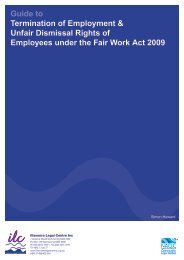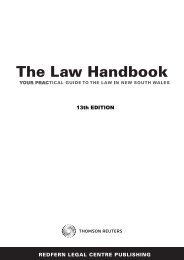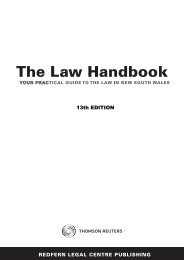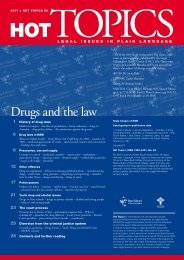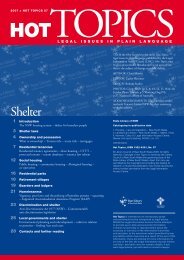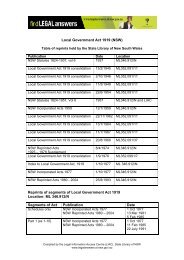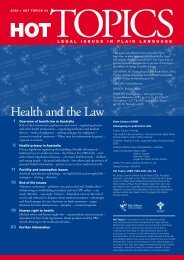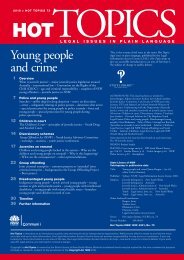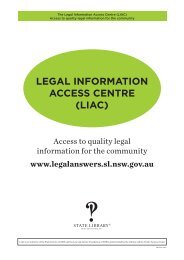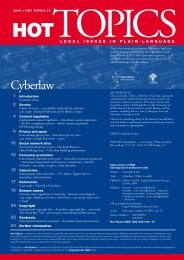Terrorism - Hot Topics 58 - Legal Information Access Centre
Terrorism - Hot Topics 58 - Legal Information Access Centre
Terrorism - Hot Topics 58 - Legal Information Access Centre
- No tags were found...
Create successful ePaper yourself
Turn your PDF publications into a flip-book with our unique Google optimized e-Paper software.
damage a country or an international organisation wherecommitted with the aim of:> seriously intimidating a population; or> unduly compelling a government or internationalorganisation to perform or abstain from performingany act; or> seriously destabilising or destroying the fundamentalpolitical, constitutional, economic or social structuresof a country or an international organisation.This definition is similar to those mentioned above inthe 1999 Terrorist Financing Convention, the Secretary-General and Security Council proposals, and the DraftUN Comprehensive Convention, although it adds thefurther possibility of terrorism being committed whereit destabilises or destroys vaguely defined ‘structures’ ofa country.Of all regional treaties, the widest definition is in theOrganisation of the Islamic Conference Convention onCombating International <strong>Terrorism</strong> 1999:any act of violence… notwithstanding its motives orintentions perpetrated to carry out an individual orcollective criminal plan with the aim of terrorisingpeople or threatening to harm them or imperillingtheir lives, honour, freedoms, security or rights orexposing the environment or any facility or publicor private property to hazards or occupying orseizing them, or endangering a national resource, orinternational facilities, or threatening the stability,territorial integrity, political unity or sovereignty ofindependent states.The definition contains many ambiguous and undefinedterms (such as ‘honour’, ‘stability’ or ‘unity’), whichmakes it difficult for individuals to know the scope oftheir legal liabilities with any certainty. More worryingly,the different elements of the definition are not cumulative,so that any threat to harm people or property amountsto terrorism – including ordinary crimes like mugging orburglary. There is a real danger that governments can usethis definition to prosecute their political opponents asterrorists, even where such opponents do not use violencebut simply threaten the ‘honour’ of a governmentleader or the ‘stability’ of a country. The treaty alsoexcludes self-determination struggles from the definitionof terrorism. The League of Arab States Conventioncontains a similar exemption, but self-determinationmovements against Arab States are an exception to theexception – that is, terrorists.TerrOrism anD THe un seCuriTyCOunCilUntil 11 September 2001, the transnational criminaltreaties above, and domestic law enforcement andpolicing, were the principal methods used by Statesto combat international terrorism. From the 1980sonwards, the UN Security Council identified particularterrorist acts or methods as threats to internationalpeace and security, such as hostage taking, hijackingand abduction; assassination; use of plastic explosives orweapons of mass destruction by non-State actors; andbombings of civilians, aircraft, embassies and UN offices.Until the 1990s and the end of the Cold War, however,the Security Council did not use its enforcement powersunder Chapter VII of the UN Charter (which allow theCouncil to require all States to take military or nonmilitaryaction against a threat to international peace orsecurity) to combat terrorism.After the 1991 Gulf War, the Council required Iraq notto commit or support terrorism, as a condition of theresolution establishing a ceasefire after that conflict. In aseries of resolutions from 1992, the Council demandedthat Libya cooperate with the UN in establishing whowas responsible for the Lockerbie aircraft bombing overScotland. When Libya refused to surrender Libyansuspects to Britain or the US, the Council imposedaircraft, military, economic and diplomatic sanctionson Libya. Ultimately, a settlement was reached in 1998where Libya agreed to hand over two suspects for trial ina Scottish court sitting in the Netherlands, resulting inconvictions. Sanctions were finally lifted in 2003 afterLibya paid compensation to the families of the victims.actions relating to al-QaedaAl-Qaeda first came to the attention of the Council in1996, when the Council imposed sanctions on Sudan forshielding those responsible for an attempted assassinationof the Egyptian President. Sudan eventually expelledOsama Bin Laden and sanctions were lifted in 2001.In 1998, the Council condemned Al-Qaeda attacks onAmerican embassies in Kenya and Tanzania, which killedmany people. Between 1998 and 2006, the Counciladopted numerous resolutions imposing sanctions onthe Taliban regime in Afghanistan, which was thoughtto be harbouring Al-Qaeda (including Osama BinLaden), and on Al-Qaeda and its associates. By 2005,the Council had listed more than 200 individuals and100 entities (such as banks or charities) associated withAl-Qaeda, including in Bosnia, Kosovo, Chechnya,Palestine, North Africa, Sudan, Kurdistan, and SouthEast Asia. There are, however, concerns that the Councilwrongly listed some people, based on a very low standardof proof and untested, incorrect evidence.after september 11After the 11 September 2001 attacks, the Councildid not authorise the use of military force to combatterrorism, but instead allowed the US to exercise its rightof self-defence under international law (see Resolution1368 (2001)). After the US attacked the Taliban andAl-Qaeda in Afghanistan, the Council later authoriseda multinational military force to help restore orderand security in Afghanistan (a similar force was laterdeployed in Iraq, after the initial US invasion in 2003which the UN had not authorised).terrorism and international Law 7




